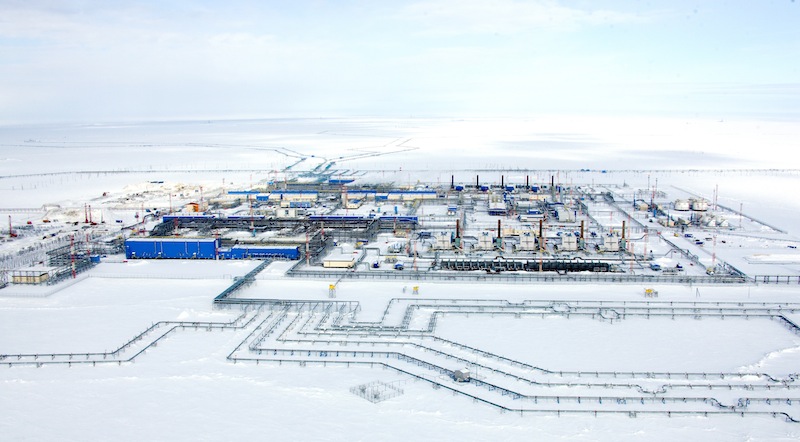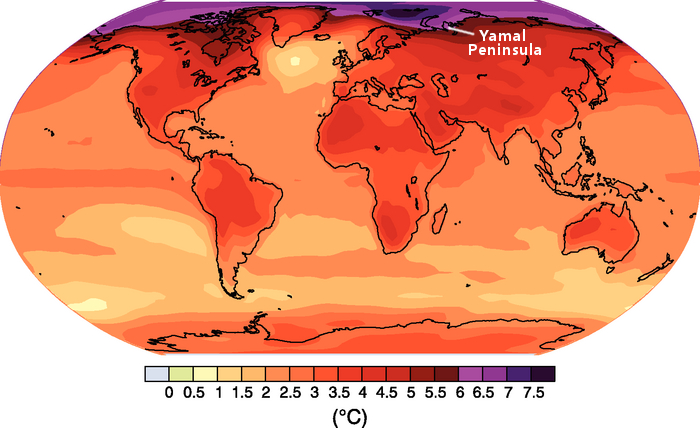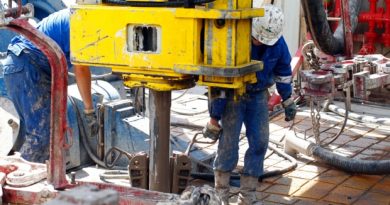Blog: Ceci n’est pas une pipe: The surrealism of Russia’s three new Arctic pipelines

On January 18, Russia’s state owned gas company, Gazprom, opened a new pipeline stretching from the frozen Bovanenkovskoye gas field of the Yamal Peninsula in Russian Arctic to Ukhta, a city in the country’s north.
The 1,265-kilometer long Bovanenkovo-Ukhta-2 pipeline runs parallel to an existing pipeline with the same name. Its opening thus doubles capacity to a combined total of 115 billion cubic meters per year.
Bovanenkovo-Ukhta-2 connects with other Russian pipelines that eventually feed into the Nord Stream pipeline. Opened in 2012, the Gazprom-supported project runs from Russia under the Baltic Sea and terminates in Germany. In other words, Bovanenkovo-Ukhta-2 can now theoretically double the amount of Arctic gas that flows to Europe every year.
The Yamal Peninsula: strength in imaginary numbers
The Yamal Peninsula lies at the heart of two of Russia’s national strategies: first, to breathe new energy into its oil and gas industry by exploiting the country’s northern resources, and second, to develop the Arctic. Gazprom notes on its website that for the gas production center in Yamal, to where its main resource base is shifting, the company has built “a railroad, which includes the world’s longest bridge beyond the Arctic Circle, and the first airport in Russia’s modern history.”
It should thus come as no surprise that Russian President Vladimir Putin, who gave a speech by videoconference commemorating the Arctic pipeline’s opening, proclaimed in his first few sentences, “This is not just a pipe” [full transcript in English/Russian]. Visions of Magritte paintings floated in my head when I read those words. Before getting too distracted by pipes, apples, and tophats, however, it’s worth situating Putin’s surreal words within their broader context. He expressed,

Putin underlined the fact that not just one, but actually three pipelines opened on Wednesday. In addition to the main attraction, Bovanenkovo-Ukhta-2, the Arctic pipelines Zapolyarye-Purpe and Kuyumba-Taishet were also unveiled. A few sentences later, Putin continued,
Gazprom CEO Alexey Miller took over next, extolling how his company laid more than 450 kilometers of pipeline “in the harshest climatic and geological conditions of the Far North.” At the same time, he stressed that the pipeline is the “most modern mainline gas pipeline in the world” (oddly, the Kremlin’s English transcript more modestly translates this sentence as “one of the most modern mainline gas pipeline in the world” (emphasis author).
Miller also plainly states that Bovanenkovo-Ukhta-2 will operate until 2087, a year that is almost farcically precise given how far it is into the future. For all we know, all of the permafrost underlying the pipeline may have turned to mush by then. Climate models suggest that the Yamal Peninsula may be over 6°C warmer by 2090.

Nikolay Tokarev, President of state-owned Transneft, the world’s largest oil pipeline company, gave the following speech. He lauded the 8,000 specialists and 4,000 pieces of heavy machinery (“We used only Russian-made equipment”) that were involved in the construction of the other two Arctic pipelines. Making sure to mention the social sphere, Tokarev also explained, “…We also took care of social issues. We built 16,000 square meters of housing, created 1,500 new jobs, built 7 bridges, and energy facilities, while budgets at different levels have received around 3 billion in taxes.”
Phew!
The announcements of numbers so large as to be incomprehensible (what, after all, constitutes 16,000 square meters of housing in human terms? Four of this Russian mansion in Rublyovka?) make the pipeline seem like an even more impressive achievement for the Russian state. It was not enough for Russia to simply open a pipeline that will ceaselessly pump Arctic gas to warm the gingerbread houses of Germany and beyond. Instead, the heads of industry and the Russian state itself, Putin, had to herald the magisterial symbolism of pipelines to the Russian nation.
The lines of steel that unify the nation
In nineteenth-century America, the opening of railroads spurred the nation’s people imagine themselves as more physically unified. In twenty-first-century Russia, the opening of pipelines is key to the country’s mastery of the Arctic, picking up a task that the Soviets left off as the twentieth century was drawing to a close. But whereas railroads at least connected communities (along with the wheat fields, cattle ranches, and orange orchards whose products they brought to market) pipelines really only connect resources to terminals. They do little to connect people or strengthen a nation’s social fabric, except when people use them in unexpected ways as has been documented by geographers like Michael Watts and others working in Nigeria. That is why it is even more important for state and business officials like Putin, Miller, and Tokarev to speak of pipelines in sublime and magical terms. If leaders endow pipelines with a certain national mystique, then the people may support them as national “infrastructure objects,” to use Putin’s words. Otherwise, citizens may ask: Where is the benefit for us? (Oh, right, it’s in the 16,000 square meters of housing.)
The Germans smoke the (Arctic) pipe
Nord Stream terminates in the German city of Greifswald. The coastal Baltic metropolis once belonged to the Hanseatic League, which was etched into the deep recesses of my brain during 10th-grade history class. While the trade alliance of the Middle Ages is most well-known for its activities around the Baltic and North Seas, there is some evidence of its involvement in the “early penetration of the North,” according to German scholar Klaus Friedland.
In a fascinating paper, he suggests that an Icelandic family may have lived in the Westphalian city of Lübeck. Using art and poetry rather than historical documents to base his findings, he determines that members of the “Ysland” family used their connections to import 12 hawks every year from Iceland. Falconry was all the rage in Europe at the time, and the North Atlantic nation was seen as having some of the most prized birds. These hawks were sent to Holy Roman Emperor Frederick II. Recently, the media has fawned over how former president Barack Obama managed to read a bevy of books in office (and even publish a paper in Science). But Frederick II wrote an entire treatise on hawking in his spare time, which is believed to have been the longest written work by any European monarch of his time or prior. In De Arte Venandi cum Avibus [The Art of Hunting with Birds], he proclaimed Icelandic birds to be the best birds, sending European hawkers and bird bandwagoners into a tizzy. The 12 hawks imported from Iceland every year were delivered to the emperor as a sort of duty, in return for which they received enough money to feed cereals 100-200 people for a year.
The buck didn’t stop with Frederick II, however. In fact, in the late 1300s, one Lübeck trading company’s bread and butter was transporting Icelandic hawks alive all the way to Alexandria, Egypt via Venice. Much as Queen Elizabeth has her Welsh corgis today, the aristocrats of Alexandria had their hawks.
Hanseatic League members later became involved in other lucrative Arctic commodity trades, like stockfish (cod). Yet today, former Hanseatic league members like Greifswald are turning to the east for northern commodities, namely Russian gas. Und so, while Emperor Frederick II once demanded Arctic commodities in the way of Icelandic hawks, today, Russia’s president is pushing Arctic commodities onto Germany in the form of Russian gas. Coincidentally, Gazprom’s CEO, Alexey Miller, comes from a Russian family of German descent.
Nord Stream II: doubling down the exploitation of Arctic gas

Gazprom is heavily pushing Nord Stream II, a pipeline that would run parallel to the current one. It is highly geopolitically contested, for it could decrease Russia’s dependence on using Eastern European countries as thoroughfares to export its gas to markets in Western Europe. Even without Nord Stream II, Gazprom’s ownership of European gas markets has been rising: it reportedly increased from 31% in 2015 to 34% last year.
In a press release published the other day on Gazprom’s website, Miller expressed,
The development of Russia’s Arctic via the exploitation of the Yamal Peninsula is inseparable from the construction of Nord Stream II under the Baltic Sea, thousands of miles away. While the pipelines bring the Arctic closer to Germany, these enormous cylinders of Russian steel cut up the peninsula’s vast reindeer pastures into smaller and smaller parcels. Their construction constricts the mobility of the nomadic indigenous Nenets people, who are already under severe pressure from climate change. As a spokesman for Greenpeace Russia remarked, “Our research shows that the biggest fear nomads have is not global climate change, but the fear of being pushed out of the tundra.”
The pipeline’s impacts on lives and lands at both ends thus prove Putin right: this is not just a pipe.
This post first appeared on Cryopolitics, an Arctic News and Analysis blog.
Related stories from around the North:
Canada: Trudeau and Obama’s Arctic endeavours, Deutsche Welle Ice-Blog
Finland: Minister Rehn not worried about Russian energy dependency, Yle News
Norway: One month after production halt, Eni resumes oil tapping at Goliat, The Independent Barents Observer
Russia: More Arctic gas for Europe as Russia opens new pipeline, The Independent Barents Observer
Sweden: Sweden to have 100 percent renewable energy by 2040, Radio Sweden
United States: Blog: Five ways the Dakota access pipeline affects the Arctic, Mia Bennett





The oil and petroleum sustainability in Russia will be stable especially when they start another oil exploration in Arctic Ocean.
They have a oil pipeline everywhere especially in Caspian, Baltic and Black Sea. Once Russia have pipeline from Arctic Ocean, their economy will be stable.
Thanks, for sharing the information, it’s very informative post!
I learn some new stuff from it too, thanks for sharing your information.
The worst part of it was that the software only worked intermittently and the data was not accurate. You obviously canot confront anyone about what you have discovered if the information is not right.
I was very pleased to find this site.I wanted to thank you for this great read!! I definitely enjoying every little bit of it and I have you bookmarked to check out new stuff you post.
There is so much in this article that I would never have thought of on my own. Your content gives readers things to think about in an interesting way. Thank you for your clear information.
I’ve read some good stuff here. Definitely worth bookmarking for revisiting. I surprise how much effort you put to create such a great informative website.
Wow, this is really interesting reading. I am glad I found this and got to read it. Great job on this content. I like it.